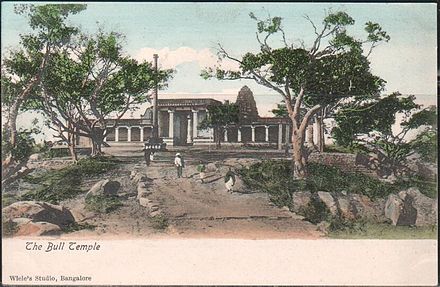Coordinates: 12°56′34.42″N77°34′5.55″E / 12.9428944°N 77.5682083°E

A geographic coordinate system is a coordinate system that enables every location on Earth to be specified by a set of numbers, letters or symbols. The coordinates are often chosen such that one of the numbers represents a vertical position and two or three of the numbers represent a horizontal position; alternatively, a geographic position may be expressed in a combined three-dimensional Cartesian vector. A common choice of coordinates is latitude, longitude and elevation. To specify a location on a plane requires a map projection.
Contents


Dodda Basavana Gudi (the Nandhi Temple) is situated in Bull Temple Road, Basavanagudi, area of South Bangalore, part of the largest city of the Indian state of Karnataka. The Hindu temple is inside a park called Bugle Rock.

Basavanagudi is a residential and commercial locality in the Indian city of Bangalore. It is located in South Bangalore, along the borders of Jayanagar. The name "Basavanagudi" refers to the Bull Temple, which contains a monolith statue of the Nandi Bull. The word Basava in Kannada means bull, and gudi means temple.

Bangalore, officially known as Bengaluru, is the capital city of the Indian state of Karnataka. It has a population of over ten million, making it a megacity and the third most populous city and fifth most populous urban agglomeration in India. It is located in southern India on the Deccan Plateau at an elevation of over 900 m (3,000 ft) above sea level, which is the highest among India's major cities. It reflects its multireligious and cosmopolitan character by its more than 1000 temples, 400 mosques, 100 churches, 40 Jain derasars, three Sikh gurdwaras, two Buddhist viharas and one Parsi fire temple located in an area of 741 km² of the metropolis. The religious places are further represented to include the few members of the Jewish community who are making their presence known through the Chabad that they propose to establish in Bengaluru and the fairly large number of Bahá'ís whose presence is registered with a society called the Bahá'í Centre.

Karnataka is a state in the south western region of India. It was formed on 1 November 1956, with the passage of the States Reorganisation Act. Originally known as the State of Mysore, it was renamed Karnataka in 1973. The state corresponds to the Carnatic region. The capital and largest city is Bangalore (Bengaluru).
The bull referred to is a sacred Hindu demi-god, known as Nandi; Nandi is a close devotee and attendant of Shiva. Dodda Basavana Gudi is said to be the biggest temple to Nandi in the world. The stone monolith idol of Nandi is continually covered with new layers of butter, benne in the local language of Kannada. There is an idol of the elephant-headed Hindu deity Ganesha close by.

Shiva also known as Mahadeva is one of the principal deities of Hinduism. He is the supreme being within Shaivism, one of the major traditions within contemporary Hinduism.

Butter is a dairy product with high butterfat content which is solid when chilled and at room temperature in some regions, and liquid when warmed. It is made by churning fresh or fermented cream or milk to separate the butterfat from the buttermilk. It is generally used as a spread on plain or toasted bread products and a condiment on cooked vegetables, as well as in cooking, such as baking, sauce making, and pan frying. Butter consists of butterfat, milk proteins and water, and often added salt.
Every year on the last Monday and Tuesday of the Hindu month of Karthika Maasa a groundnut fair is held in the temple premises and groundnut is offered to the deity. This fair is known as 'Kadalekaayi Parishe' in local tongue. Groundnut sellers and devotees throng the place during Kadalekaayi Parishe.
Kadalekai Parishe, is an annual groundnut fair held in Bangalore. This two-day fair is held near the Dodda Ganesha Temple in Basavanagudi. Apart from the Groundnuts, there are numerous stalls in the fair, selling Bangles, traditional toys and clay trinkets, plastic and glass dolls, Mehndi tattoos. There are a variety of food items, such as Bajji, Bonda, Batthaas, Kalyana seve or Bendu and Coloured sodas on sale during the fair. Over 200 groundnut vendors were benefited and the total plastic consumption at the fair came down by over 60%.
Basavana Gudi is a regular place of visit for tourists and is covered by most of the tour operators including the Karnataka State Tourism Development Corporation.
Karnataka State Tourism Development Corporation or KSTDC is an organisation that was established by the Government of Karnataka state in India to promote Tourism in Karnataka.























